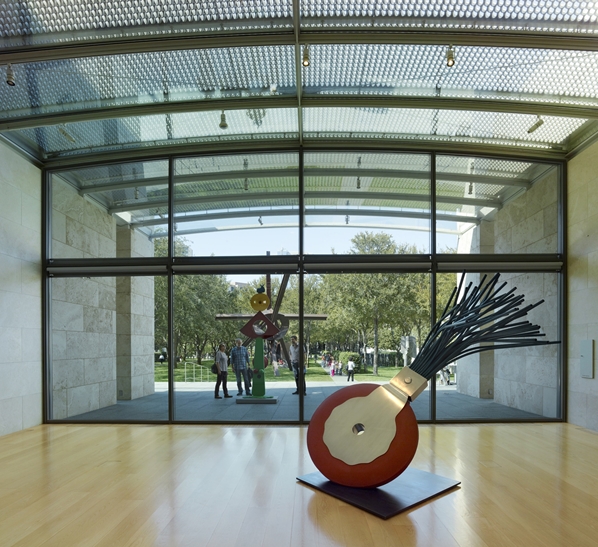
Photo: Tim Hursley.
Claes Oldenburg Typewriter Eraser (9176) in Gallery II at the Nasher Sculpture Center.
Photo: Tim Hursley.
Sculpture in the Shade at the Nasher
Following three years of bitter dispute, a luxury high-rise in Dallas has hired experts to help cut the glare its reflective surface casts on the Nasher Sculpture Center below.
Trustees of the 42-story Museum Tower have brought in Hines, an international real-estate firm which handled similar issues at the Frank-Gehry designed Walt Disney Concert Hall in Los Angeles, to suggest and implement solutions.
Will the Nasher finally see the dark at the end of the tunnel? “We are hopeful,” said Nasher director Jeffrey Strick, praising Hines in emails. “It’s already tapping into its network of experts around the world to identify the latest technology that can be used to resolve the problems created by the tower’s intense reflections.” He stressed that the “damaging glare” continues to impact viewing of the art.
A spokeswoman for the museum noted that a show of David Bates that opened two weeks ago is affected by the Museum Tower glare as it projects stripes and honeycomb patterns on the sculpture in the galleries.
The dispute has been going on for nearly three years; the Museum Tower first suggested changes to the Nasher’s Renzo Piano-designed roof to solve the problems; the Nasher, in conversation with Piano, declined, calling proposed solutions “grossly inadequate and deeply flawed.” The most tense moment, perhaps, came when artist James Turrell visited his sculpture installed in the garden, Tending (Blue). A sign was added to the artwork noting that as the view from it “is now obstructed by the Museum Tower, the artist, James Turrell, has declared the work destroyed.”
Complicating the matter is that the building is owned by the Dallas Police and Fire Pension System, an entity which many in Dallas would certainly root and has considerable public support.
But there are lessons to be learned here that go far beyond the Texas border. It’s been reported that Ray Nasher, before his death, had a handshake agreement with the Pension Fund that the building would not exceed 20 floors. (Both of the first two iterations of the design were 22 floors or under, according to the Nasher). If so, he, not to mention Albert Barnes, are looking down from whatever cushy putti-decked heaven that arts philanthropists end up in, fuming. These agreements need to be airtight.
Nasher Sculpture Center, interior.
On a personal note, on a recent visit to the Nasher Sculpture Center, the glare was not as disturbing to me as the simple scale of the building, a menacing and unpleasantly placed Goliath in looming relation to the peaceful Nasher garden. For a city arts district, not pretty. But it’s unlikely they’ll slice off 20 floor—even if they remain unsold. (The Museum Tower recently reported sales of about 25 percent, although local publications questioned the numbers.)
That said, if Nasher had simply left his collection to the Dallas Art Museum, as he had long considered doing, instead of creating a bespoke institution, it just might have had more political clout to fight on his behalf.
Defining Culture and Its Motivations
A big, sweeping study on cultural participation across America was released earlier this week and featured much info you might have expected: declining subscriptions and membership at arts institutions, declining attendance for dramatic plays, lingering effects of the recession on audience spending, etc.
But among the more surprising findings of the two-year LaPlaca Cohen “Culture Track 2014” study was that millennials, defined by the researchers as 18-to-29 year-olds, go to cultural events for “stress reduction” more than any other age group, are “culturally promiscuous” and that, also more than any other age group, they won’t attend cultural events alone. And, strikingly, a majority of all respondents, regardless of age, defined visits to parks, food fairs and watching television to be cultural activities.
The concrete advice for arts organizations based on the findings included marketing events much earlier, integrating mobile devices and not counting too much on Facebook to get the word out, as is popularity appears to be dimming among younger users.
But theater and film director Julie Taymor, who spoke on a panel regarding the survey, cautioned against reading too much, or changing art or policy, based on any market research. If she had polled people before the hugely successful “Lion King,” she noted, “Mufasa wouldn’t have died.”
“It’s ours. Give it back.”
Finally, someone said it.
In the midst of a museums conference sponsored by the American Federation for the Arts that dealt mostly with the art market, Thaddeus J. Stauber, a partner at Peabody Nixon LLP, said, almost as an aside, something that should have been said years ago.
“There was a bit of naivete” in the well-meaning museum community about repatriation disputes, according to Mr. Stauber. For some claimants, said the head of Peabody Nixon’s Art and Cultural Institutions team, “it’s a business, it has become an industry.”
In the past two decades, the knee-jerk reaction of museums has been to return any claimed or disputed artwork or antiquity whole-hog . . . one of the most expensive and sad reallotment of the world’s treasures. Not that there wasn’t significant unethical activity going in some cases, and deeper moral issues to be wrestled with in many, but some national claimants were defining any exported material as theft years after the fact. They were essentially inventing retroactive crime.
It would be a welcome change if the pendulum is swinging towards more thoughtful decisions.
Art World Report Card appears every Thursday. The author can be reached at apeers@artnet.com and writes on the art world on Twitter @LoisLaneNY.